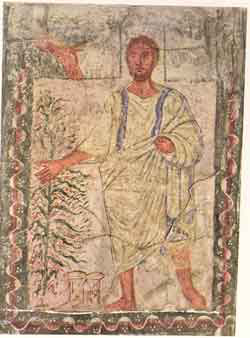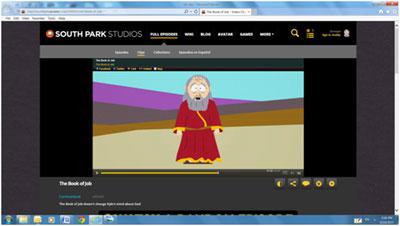
The enigma of the book of Job is expressed in the satirical cartoon series Southpark, in which Kyle (aka Job), recovering from hemorrhoid surgery, gets a visit from Rabbi and Rebbetzin Schwartz. They try to cheer Kyle up by telling him the story of Job. In the Rabbi’s version, Job is a wonderful man, has many children, a great wife and much livestock and praises God. God gets a terrible idea from Satan, who says that Job only praises God because he is so well off: “Take away all his goods and see what happens.” Everything is lost and Job gets deathly sick, but still praises God. Kyle says, “That’s it? Why would God do such a thing to a good person?” The Rabbi, perplexed, answers: “I don’t know.” Kyle’s closing remarks are: “There is no God.”
This is Bible study in our own day. It’s true and it’s not true. It’s partial and like anything partial, a lot is left out and some is added, just as in the world of midrash
Missing from the Southpark version of the story of Job are Job’s wife's problematic response to Job's disaster, Job’s extended discussion with his companions, God’s awesome revelation to Job and the detailed account of Job’s restoration. Both written and visual commentary on the book of Job have highlighted some of these figures and scenes, often well beyond their importance in the book. These commentaries reread and revisualize Job, through associations with the issues of their own times and in accordance with local, religious and individual agendas.
In our essay, we will go back to the 4th century and examine the art of that painful book throughout the centuries in order to track how Job and his story metamorphosed in the eyes of artists and why.
Missing from the Southpark version of the story of Job are Job’s wife's problematic response to Job's disaster, Job’s extended discussion with his companions, God’s awesome revelation to Job and the detailed account of Job’s restoration. Both written and visual commentary on the book of Job have highlighted some of these figures and scenes, often well beyond their importance in the book. These commentaries reread and revisualize Job, through associations with the issues of their own times and in accordance with local, religious and individual agendas.
In our essay, we will go back to the 4th century and examine the art of that painful book throughout the centuries in order to track how Job and his story metamorphosed in the eyes of artists and why.
Early Christian art
Job first appears in the art of 4th century Rome in association with Christian views of death and burial.
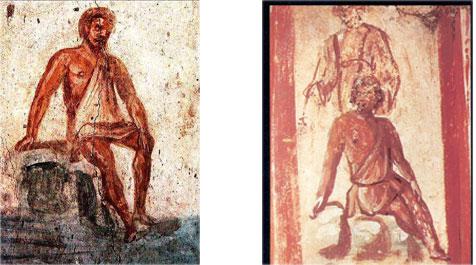
In the paintings of the Roman catacombs, Job assumes the classic stance of the thoughtful scholar; in the funereal context of the catacombs, he embodies (and recommends) a contemplative approach to death.
In one catacomb painting, Job's wife accompanies him. Although she appears in the biblical text in only one short passage, she stars in commentary, midrash and the visual arts. As we shall discuss, in some cases, she is cast as a caring wife and in others, as a shrew. In the catacombs, she stands above and behind Job, holding a stick and looking away from him. What does this positioning of the couple tell us?
In one catacomb painting, Job's wife accompanies him. Although she appears in the biblical text in only one short passage, she stars in commentary, midrash and the visual arts. As we shall discuss, in some cases, she is cast as a caring wife and in others, as a shrew. In the catacombs, she stands above and behind Job, holding a stick and looking away from him. What does this positioning of the couple tell us?
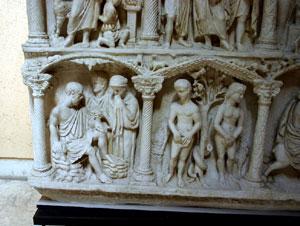
The many vignettes on the contemporary Junius Bassus sarcophagus – scenes from the Hebrew Bible and New Testament – can help us, since they too express early Christian beliefs on death and resurrection. Job appears here again as a robust philosopher, contemplating his fate. His wife holds a cloth to her face and extends her hand toward Job; from later iconography, it appears that, as in the catacombs, she originally held a stick, which broke in the course of the centuries. Later examples will clarify that she covers her face because Job's sores stink; the stick enables her to give him food while keeping her distance. Thus, both in the catacombs and in the sarcophagus of Junius Bassus, Job's wife is a comforting figure.
A third figure stands between the couple on the sarcophagus. The identity of this figure can be determined by comparing our scene with the adjacent panel – the fall of Man. There, Adam and Eve flank the serpent; from this juxtaposition we can conclude that Job and his wife flank Satan. Is this early Christian artist saying that Job’s (everyman’s) suffering is the result of Original Sin? In any event, early Christian art sees Job as a contemplative, pondering life and death.
A third figure stands between the couple on the sarcophagus. The identity of this figure can be determined by comparing our scene with the adjacent panel – the fall of Man. There, Adam and Eve flank the serpent; from this juxtaposition we can conclude that Job and his wife flank Satan. Is this early Christian artist saying that Job’s (everyman’s) suffering is the result of Original Sin? In any event, early Christian art sees Job as a contemplative, pondering life and death.
Byzantine art
In a ninth century Greek manuscript of the book of Job, the same three figures from Junius Bassus evolve dramatically.
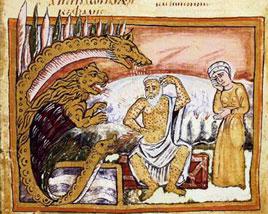
9th century
Dominating almost half the picture, Satan, on the left, becomes the Chimera of Greek mythology: a dragon, a lion and a serpent. Job is still robust, wearing the remnant of a toga; but he looks pathetic, covered with sores and scratching his head and body. His sorrowing wife stands at the right. Here the monstrous torment of Job by Satan, rather than the couple's philosophical and practical response to death, is the main focus.
In the next picture from the same manuscript, Job’s life is literally circumscribed by his suffering
In the next picture from the same manuscript, Job’s life is literally circumscribed by his suffering
(ח) וַיִּֽקַּֽח־ל֣וֹ חֶ֔רֶשׂ לְהִתְגָּרֵ֖ד בּ֑וֹ וְה֖וּא יֹשֵׁ֥ב בְּתוֹךְ־הָאֵֽפֶר׃
(8) He took a potsherd to scratch himself as he sat in ashes.
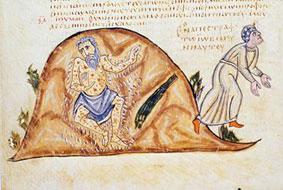
Codex Gr. 749 VAT749, folio 27r, 9th century
Job and his wife continue to speak:
(ט) וַתֹּ֤אמֶר לוֹ֙ אִשְׁתּ֔וֹ עֹדְךָ֖ מַחֲזִ֣יק בְּתֻמָּתֶ֑ךָ בָּרֵ֥ךְ אֱלֹהִ֖ים וָמֻֽת׃ (י) וַיֹּ֣אמֶר אֵלֶ֗יהָ כְּדַבֵּ֞ר אַחַ֤ת הַנְּבָלוֹת֙ תְּדַבֵּ֔רִי גַּ֣ם אֶת־הַטּ֗וֹב נְקַבֵּל֙ מֵאֵ֣ת הָאֱלֹהִ֔ים וְאֶת־הָרָ֖ע לֹ֣א נְקַבֵּ֑ל בְּכׇל־זֹ֛את לֹא־חָטָ֥א אִיּ֖וֹב בִּשְׂפָתָֽיו׃ {פ}
(9) His wife said to him, “You still keep your integrity! Blaspheme God and die!” (10) But he said to her, “You talk as any shameless woman might talk! Should we accept only good from God and not accept evil?” For all that, Job said nothing sinful.
Overcome by her husband’s suffering, she suggests what we would call today “assisted suicide”. Job responds angrily to her “foolishness”.
We must note at this point that the Septuagint reading of Job’s wife’s speech is significantly expanded, declaiming her own parallel misery:
We must note at this point that the Septuagint reading of Job’s wife’s speech is significantly expanded, declaiming her own parallel misery:
9 Then after a long time had passed, his wife said to him, “How long will you persist and say, ‘Look, I will hang on a little longer, while I wait for the hope of my deliverance?’ For look, your legacy has vanished from the earth—sons and daughters, my womb’s birth pangs and labors, for whom I wearied myself with hardships in vain. And you? You sit in the refuse of worms as you spend the night in the open air. As for me, I am one that wanders about and a hired servant—from place to place and house to house, waiting for when the sun will set, so I can rest from the distresses and griefs that now beset me. Now say some word to the Lord and die!”
In this version, Job’s wife speaks “after a long time” not only of his suffering, but of her own. As a result, her outburst is more understandable than in the Hebrew text. As we shall see, these two versions reflect two contrasting attitudes toward Job’s wife. While some see her suggestion as abetting Satan, others read it as the desperate solution of a helpless, caring wife.
In our picture, Job, stripped of his toga, is reduced “after a long time” to a loin cloth, exposing his boils and wounds. Hands play out the conversation. Job’s wife leaves him, gesturing as if to say “I just don’t understand you!” Job pushes her away, as if to say “It’s clear you don’t understand me.”
A century later, his three companions accompany Job and his wife.
In our picture, Job, stripped of his toga, is reduced “after a long time” to a loin cloth, exposing his boils and wounds. Hands play out the conversation. Job’s wife leaves him, gesturing as if to say “I just don’t understand you!” Job pushes her away, as if to say “It’s clear you don’t understand me.”
A century later, his three companions accompany Job and his wife.
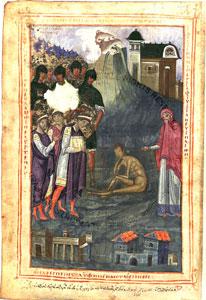
10th century
They are dressed as kings, although they are nothing of the sort in the book itself. Job is central in his misery; no longer a robust philosopher, he is now naked, covered with sores and emaciated. The treatment of Job’s wife clarifies our earlier pictures; again she holds out a stick with food, while covering her face to avoid Job’s stench. The now regal companions are perhaps based on the iconography of the three Magi in scenes of Jesus’ nativity. Job’s wife is reminiscent of Mary at the Crucifixion. And Job is Jesus. Job has now become the type of Jesus, from Nativity to Crucifixion.
Another Byzantine manuscript, this time from the 13th century, is our first example of the suffering Job crowned with a halo. It is also the first portrayal of musicians in association with Job.
Another Byzantine manuscript, this time from the 13th century, is our first example of the suffering Job crowned with a halo. It is also the first portrayal of musicians in association with Job.
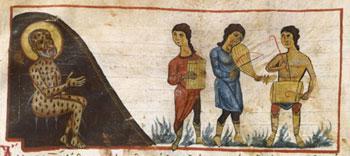
Book of Job, 12 - 14th century
Later on, these musicians will become a standard and puzzling presence in the iconography of Job. Here they illustrate a verse from Job 21 that talks about the paradoxical good fortune of the wicked:
(יב) יִ֭שְׂאוּ כְּתֹ֣ף וְכִנּ֑וֹר וְ֝יִשְׂמְח֗וּ לְק֣וֹל עוּגָֽב׃
(12) They sing to the music of timbrel and lute,And revel to the tune of the pipe;
Until now, we have seen how Job was treated in the Roman world; first in Rome itself and subsequently in Byzantium. We will now follow Job’s transformation in the world of medieval and Renaissance Europe.
Job in the West
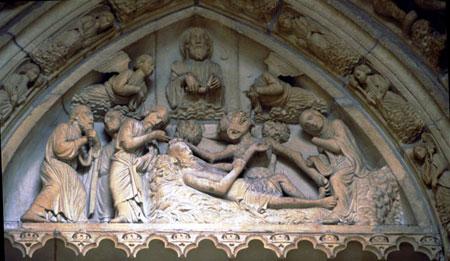
Chartres Cathedral, 13th century
The Cathedral of Chartres is a major monument of high Gothic art in the 12th and 13th centuries. Three central issues dominated Church thinking in this period: 1) the rise of the adoration of Mary as the embodiment of the Church, 2) the unity of Christ and the Church and 3) attacks on Catholic orthodoxy. The Catholic Church was beset in this period by challenges to its authority, including the militant revolt of the Albigensians. It seems that the sculptures that decorate the façade of Chartres were meant to project the struggle against these heresies, strengthening the status of Mother Church.
The figure of Job appears in Chartres as part of the enormous Royal Portico populated entirely by figures from the Hebrew Bible. Reflecting the above agenda, Job lies central in his agony. As we have seen, elsewhere Job is seated, in accordance with the text. Here, Satan lifts his face heavenward, cackling with joy at Job’s suffering. Job’s supine posture allows Satan to dominate him, his demonic grip extending the entire length of his body, as in the biblical text.
The figure of Job appears in Chartres as part of the enormous Royal Portico populated entirely by figures from the Hebrew Bible. Reflecting the above agenda, Job lies central in his agony. As we have seen, elsewhere Job is seated, in accordance with the text. Here, Satan lifts his face heavenward, cackling with joy at Job’s suffering. Job’s supine posture allows Satan to dominate him, his demonic grip extending the entire length of his body, as in the biblical text.
(ז) וַיֵּצֵא֙ הַשָּׂטָ֔ן מֵאֵ֖ת פְּנֵ֣י יהוה וַיַּ֤ךְ אֶת־אִיּוֹב֙ בִּשְׁחִ֣ין רָ֔ע מִכַּ֥ף רַגְל֖וֹ (עד) [וְעַ֥ד] קׇדְקֳדֽוֹ׃
(7) The Adversary departed from the presence of the LORD and inflicted a severe inflammation on Job from the sole of his foot to the crown of his head.
At his feet, Job’s wife (arms now missing) probably held out his food on a stick, as in earlier images. At Job’s head, stand the so-called friends. Two of them are planning their arguments, while the third bends over Job gesturing, his hand touching Satan’s. If Job is the Church, Satan, Job’s wife and the “friends” represent the challenge. Christ, center and above accompanied by angels, represents the Church’s victory, validating the suffering of Job.
The suffering of Job achieves its most macabre expression in two 14th century French paintings from a manuscript of the Bible Historiale. The Bible Historiale is a French translation and adaptation of Peter Comestor’s Latin paraphrase of the historical books of the Bible. Written by the cleric Guyart des Moulins in the 1290s, the original version abbreviates the book of Job to the bare minimum of its plot. In later versions, a translation of the entire book of Job was added. In our manuscript from ca. 1340, both the long and the short Jobs are included, side by side. Our two pictures accompany the two texts.
The suffering of Job achieves its most macabre expression in two 14th century French paintings from a manuscript of the Bible Historiale. The Bible Historiale is a French translation and adaptation of Peter Comestor’s Latin paraphrase of the historical books of the Bible. Written by the cleric Guyart des Moulins in the 1290s, the original version abbreviates the book of Job to the bare minimum of its plot. In later versions, a translation of the entire book of Job was added. In our manuscript from ca. 1340, both the long and the short Jobs are included, side by side. Our two pictures accompany the two texts.
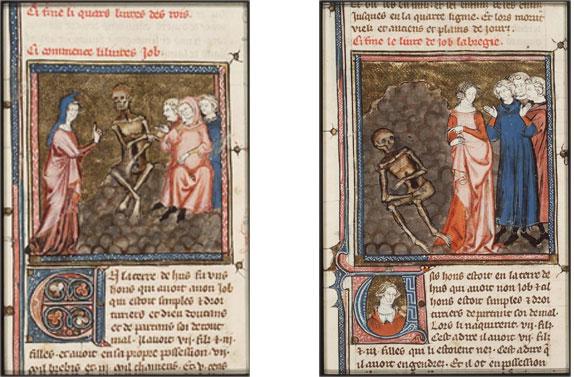
In both paintings, Job is a deathly skeleton accompanied by his wife and the three companions. But the moods of the two paintings are different. In the shorter version, finger pointing illustrates confrontation with Job in the middle. His legs are crossed, identifying him with Jesus. His wife points upward as if to say “Curse God and die”. Job looks at her, but at the same time points to one of the companions, as if they are quarreling, while the third friend stands back in silent gloom.
In the longer version, Job sits to the side as if listening. His wife and companions are talking about him, rather than to him. She might be affirming Job’s suffering, while the lead companion throws up his hands as if to say, “He must deserve it”.
Job has become Death itself; his very existence is a problem for those who surround him.
In the longer version, Job sits to the side as if listening. His wife and companions are talking about him, rather than to him. She might be affirming Job’s suffering, while the lead companion throws up his hands as if to say, “He must deserve it”.
Job has become Death itself; his very existence is a problem for those who surround him.
Job the Patient and Job with Musicians
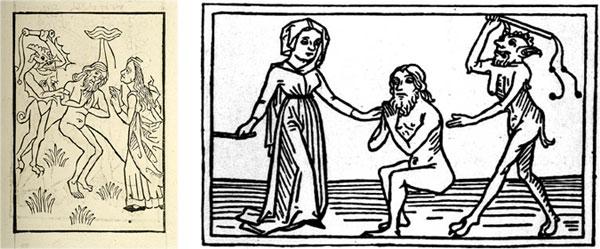
Speculum, Basel, Speculum, Augsburg, 1473 1471 - 1481
Job’s character undergoes another significant transformation in 15th century northern Europe as witnessed in the two drawings above. His sores, so prominent earlier, have disappeared. His prayerful hands emphasize the quality of patience and stoicism. Job sits awkwardly in both illustrations. In the left hand drawing, his knees are bent, since he is sitting on the dunghill; but on the right, the dunghill has disappeared. The original iconography has been decontextualized.
Job is caught between two aggressive opponents. The extended arms from each direction harass Job’s body. A particularly grotesque Satan, with breasts, hooves and a tail is whipping Job. Opposite stands Job’s wife, holding a stick. Earlier, she had given Job food using this stick, but now it is parallel to Satan’s whip.
Up to now, Job’s wife appeared as a comforter. But in 15th century Europe we begin to see a negative attitude toward her. The text of the Basel Speculum (above left) identifies our picture : Job flagellabatur a demone et ab uxore (Job was whipped by the Devil and by his wife). The Augsburg Speculum also sees her as menacing. Thus in both cases she is, as John Chrysostom, Augustine and Gregory the Great had already said, a helper of the Devil, undermining Job’s faith.
Note,too, the mysterious (divine?) element that hovers over Job in the Basel Speculum - an indifferent witness to his suffering.
Job is caught between two aggressive opponents. The extended arms from each direction harass Job’s body. A particularly grotesque Satan, with breasts, hooves and a tail is whipping Job. Opposite stands Job’s wife, holding a stick. Earlier, she had given Job food using this stick, but now it is parallel to Satan’s whip.
Up to now, Job’s wife appeared as a comforter. But in 15th century Europe we begin to see a negative attitude toward her. The text of the Basel Speculum (above left) identifies our picture : Job flagellabatur a demone et ab uxore (Job was whipped by the Devil and by his wife). The Augsburg Speculum also sees her as menacing. Thus in both cases she is, as John Chrysostom, Augustine and Gregory the Great had already said, a helper of the Devil, undermining Job’s faith.
Note,too, the mysterious (divine?) element that hovers over Job in the Basel Speculum - an indifferent witness to his suffering.
In the art of northern Europe of the late 15th century, three musicians suddenly appear accompanying Job the pious. They also appear in several French and English poems and plays of the time, but their origin is unknown. While they often seem to be additional mockers of Job, some of the visual and literary sources cast them as comforters. Sometimes, they take the place of Job’s companions; in other cases, they are additional characters.
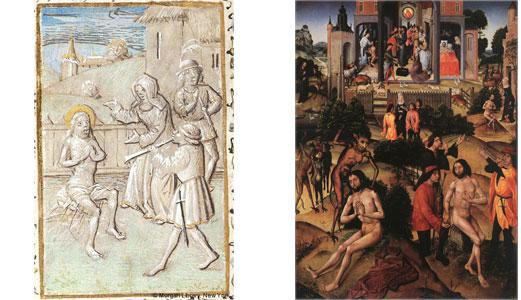
Book of Hours, Triptych of a Flemish Master, Belgium, 1470 1480
As we have seen above musicians first appear in Byzantine art; however, there they are not characters in Job’s drama, but mere symbols of the success of the wicked (see Job 21).
In this 15th century Book of Hours, they appear to be ridiculing the praying, haloed Job. Job’s wife claps her hands and taps her foot, in rhythm with the music.
At exactly the same time, the musicians appear in great detail in a panel of a Flemish triptych. Eight scenes from the story of Job fill the panel. At front stage we see Job twice, seated on the dunghill. On the left a hideous Satan flails the praying saint. On the right, two musicians blast their horns while the third is collecting his honorarium from the victim himself. According to the literary sources, Job pays them with his scabs, magically transformed into gold. In the center of the painting, Job’s wife is talking with the musicians. According to the English poem, The Life of Holy Job:
In this 15th century Book of Hours, they appear to be ridiculing the praying, haloed Job. Job’s wife claps her hands and taps her foot, in rhythm with the music.
At exactly the same time, the musicians appear in great detail in a panel of a Flemish triptych. Eight scenes from the story of Job fill the panel. At front stage we see Job twice, seated on the dunghill. On the left a hideous Satan flails the praying saint. On the right, two musicians blast their horns while the third is collecting his honorarium from the victim himself. According to the literary sources, Job pays them with his scabs, magically transformed into gold. In the center of the painting, Job’s wife is talking with the musicians. According to the English poem, The Life of Holy Job:
The mynstrelles than shewid and tolde to Job his wyfe,
That he so reward them where fore she gan to stryfe
That he so reward them where fore she gan to stryfe
In the continuation of the poem, she complains that Job has enough money to pay the musicians, but not to feed her.
Job’s wife also appears in the typical meeting on the dunghill and again in the scene (at top) of his deathbed. Thus she is the linchpin of the complex action and enormous cast of the painting. Once again, she is cast as another tormentor of Job.
Just as they suddenly appear, so the musicians disappear without a trace by the mid-16th century.
Just as they suddenly appear, so the musicians disappear without a trace by the mid-16th century.
Job in Jewish literary and visual midrash
The book of Job is referenced frequently in Jewish midrash and commentary from their earliest stages, although not as intensively as other books of the Bible. The major theme in these Jewish interpretations contrasts Job’s and Abraham’s trials, especially with regard to the Akedah. However, there is very little Jewish art on Job before the modern era. Job does not appear in haggadot, in haftarot or in mahzorim for the simple reason that the book of Job is not part of the Jewish liturgical cycle. The same is true of the books of Daniel, Chronicles and Ezra and Nehemiah. Curiously, these very books are cited in Mishna Yoma as the material read to the High Priest to keep him awake on the eve of Yom Kippur.
(ו) אִם הָיָה חָכָם, דּוֹרֵשׁ. וְאִם לָאו, תַּלְמִידֵי חֲכָמִים דּוֹרְשִׁין לְפָנָיו. וְאִם רָגִיל לִקְרוֹת, קוֹרֵא. וְאִם לָאו, קוֹרִין לְפָנָיו. וּבַמֶּה קוֹרִין לְפָנָיו, בְּאִיּוֹבוּבְעֶזְרָא וּבְדִבְרֵי הַיָּמִים. זְכַרְיָה בֶּן קְבוּטָל אוֹמֵר, פְּעָמִים הַרְבֵּה קָרִיתִי לְפָנָיו בְּדָנִיֵּאל:
(6) They kept him occupied throughout the night to prevent him from sleeping. If he was a scholar, he would teach Torah. If he was not a scholar, Torah scholars would teach Torah before him. And if he was accustomed to read the Bible, he would read; and if he was not, they would read the Bible before him. And what books would they read before him to pique his interest so that he would not fall asleep? They would read from Job, and from Ezra, and from Chronicles. Zekharya, son of Kevutal, says: Many times I read before him from the book of Daniel.
Nonetheless we have a skimpy handful of art in Jewish books, spanning the 13th through the 15th century and originating in both northern and southern Europe. How do these few examples of Jewish iconography relate to the Christian iconography we’ve seen up to now?
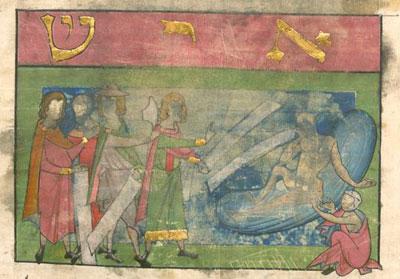
Although these few works of art appear in Hebrew Bibles and commentaries, the artwork was done mainly by Christians and at least one treatment was intended for a non-Jewish audience. For example, the colophon of the Munich manuscript of Rashi’s commentary records the name of the scribe, Shelomo ben R. Shmuel; from comparison with other manuscripts, we know that the illustrator was one “Heinrich the Painter”. In other words, a Jew and a Christian collaborated on a long term project in 13th century Germany, contrary to the generally assumed alienation of the two communities. Unlike the norm, this painting shows four visitors rather than three; two of them are wearing the infamous Jewish hat (Judenhut). The speaker, probably Elihu, takes center stage. Speech scrolls represent the conversation between him and Job. Three remaining speech scrolls give voice to the other three companions. Focusing on Elihu’s speech is very unusual and even enigmatic in a manuscript in which there is only a single picture on the book of Job.
Job is naked, seated on a palette-shaped dunghill. As opposed to the preceding works, his posture goes back to that of the Roman philosopher Job (see above), robust and thoughtful.
The iconography of Job and his wife is remarkable. His left hand is extended toward her, almost affectionately (?). Her left arm reaches out to him. She crouches next to her husband, communicating without speech. This sympathetic relationship seems to hark back to the early Christian model, as does the portrayal of Job himself. Perhaps this "Christian" model was actually Jewish.
All the faces (here and throughout the manuscript) have been rubbed out; apparently, a “correction” made by the Christian illuminator on the demand of the Jewish backer. Such iconoclasm is prevalent at this time in Ashkenazic manuscripts – see for example the Birds' Head Haggadah.
The only rendering of Satan in medieval “Jewish art” that has come down to us is in Cambridge Ee. 5.9, an illuminated Hagiographa (Writings), dated in its margin to 1347, and created in Germany, as verified by several Yiddish comments of its scribe.
Job is naked, seated on a palette-shaped dunghill. As opposed to the preceding works, his posture goes back to that of the Roman philosopher Job (see above), robust and thoughtful.
The iconography of Job and his wife is remarkable. His left hand is extended toward her, almost affectionately (?). Her left arm reaches out to him. She crouches next to her husband, communicating without speech. This sympathetic relationship seems to hark back to the early Christian model, as does the portrayal of Job himself. Perhaps this "Christian" model was actually Jewish.
All the faces (here and throughout the manuscript) have been rubbed out; apparently, a “correction” made by the Christian illuminator on the demand of the Jewish backer. Such iconoclasm is prevalent at this time in Ashkenazic manuscripts – see for example the Birds' Head Haggadah.
The only rendering of Satan in medieval “Jewish art” that has come down to us is in Cambridge Ee. 5.9, an illuminated Hagiographa (Writings), dated in its margin to 1347, and created in Germany, as verified by several Yiddish comments of its scribe.
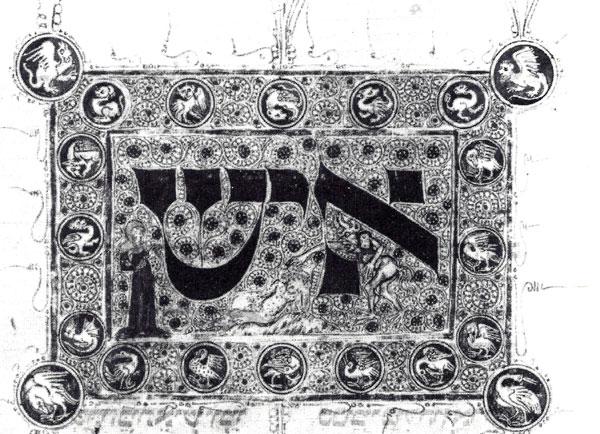
Satan is a spectacular monster, with a grotesque, horned head, tail and webbed feet as in the Speculums discussed above. He stretches over the stem of the aleph to strike Job’s head, as in the Chartres relief ; but he has no whip as in other renditions. Job, with blistering sores, reclines on the dungheap. His angry wife stands as far as possible from him on the left. Their faces have been erased, as in the Munich Rashi. In sum, while the iconography of this Job identifies it clearly as the work of a Christian artist, like the Munich Rashi, it straddles both worlds.
Our last group of medieval illustrations of Job comes from 15th century Italy.
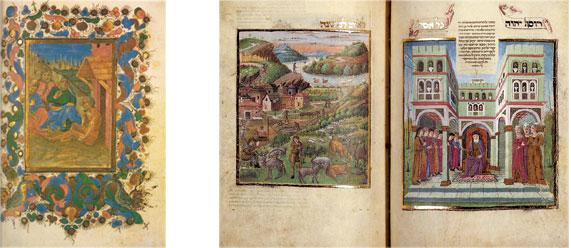
On the left, the painting is from a manuscript of the Hebrew text of Job, Proverbs and Psalms (called by the acronym Sifrei EMeT – the books of TRUTH); the manuscript was commissioned by the Medici family, the rulers of Florence. Here, scarred Job scratches himself with a shard but appears to be listening, although his gaze is far off. The three companions are seated:
(יג) וַיֵּֽשְׁב֤וּ אִתּוֹ֙ לָאָ֔רֶץ שִׁבְעַ֥ת יָמִ֖ים וְשִׁבְעַ֣ת לֵיל֑וֹת וְאֵין־דֹּבֵ֤ר אֵלָיו֙ דָּבָ֔ר כִּ֣י רָא֔וּ כִּי־גָדַ֥ל הַכְּאֵ֖ב מְאֹֽד׃
(13) They sat with him on the ground seven days and seven nights. None spoke a word to him for they saw how very great was his suffering.
But two of the three gesture, indicating speech, while the third clasps his hands piously, a gesture normally associated with Job. Therefore, our view is that this painting summarizes the thirty chapters detailing Job’s meeting with his companions, rather than just illustrating Job 2:13.
On the right, the Rothschild Miscellany was commissioned by Moses ben Yekuthiel Hakohen, a wealthy Italian Jew, in 1479. This pair of pictures carries a happy title “the Lord gave Job twice what he had before” (Job 42:10), (contra Sed-Rajna’s claim that this is Job’s beginning). This period of prosperity for Italian Jewry is reflected in the portrayals of Job’s restoration; plenty, peace, even better than before. Job’s material wealth is shown in the left-hand scene; land, flocks, real estate. All is good with the world. In the right hand picture, Job’s family is restored. He is seated in the center of his palazzo, a bearded patriarch, surrounded by his seven sons and three daughters; his wife is absent. All signs of suffering and loss have magically disappeared. This pair of pictures, attached to Jewish commentary on the last part of the book of Job, is a radical departure from the more common stress on Job the martyr. It may be the only example of pre-modern “Jewish art” on Job; while the other paintings in Hebrew manuscripts are very similar to the Christian art of the times, Job in his palazzo is Job from a Jewish perspective.
Before parting from the art of pre-modern Europe, we must show you a most unusual Job.
On the right, the Rothschild Miscellany was commissioned by Moses ben Yekuthiel Hakohen, a wealthy Italian Jew, in 1479. This pair of pictures carries a happy title “the Lord gave Job twice what he had before” (Job 42:10), (contra Sed-Rajna’s claim that this is Job’s beginning). This period of prosperity for Italian Jewry is reflected in the portrayals of Job’s restoration; plenty, peace, even better than before. Job’s material wealth is shown in the left-hand scene; land, flocks, real estate. All is good with the world. In the right hand picture, Job’s family is restored. He is seated in the center of his palazzo, a bearded patriarch, surrounded by his seven sons and three daughters; his wife is absent. All signs of suffering and loss have magically disappeared. This pair of pictures, attached to Jewish commentary on the last part of the book of Job, is a radical departure from the more common stress on Job the martyr. It may be the only example of pre-modern “Jewish art” on Job; while the other paintings in Hebrew manuscripts are very similar to the Christian art of the times, Job in his palazzo is Job from a Jewish perspective.
Before parting from the art of pre-modern Europe, we must show you a most unusual Job.
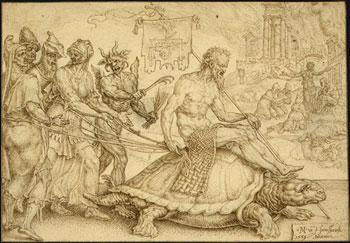
Not the suffering, not the restored, but the defiant Job is seated upon a huge tortoise (a symbol of patience and endurance) and pulls behind him his detractors: Satan, his wife and his so-called friends. They are looking at each other, as if stupefied by Job’s vindication. In the faded background is a scene from Job’s earlier life; his wife stands and gesticulates impatiently while the three companions are still overcome by Job’s tragedy.
Muslim art
We next treat four Islamic paintings of Job (Ayyub), all created in Persia within a period of just five years in the late 16th century.
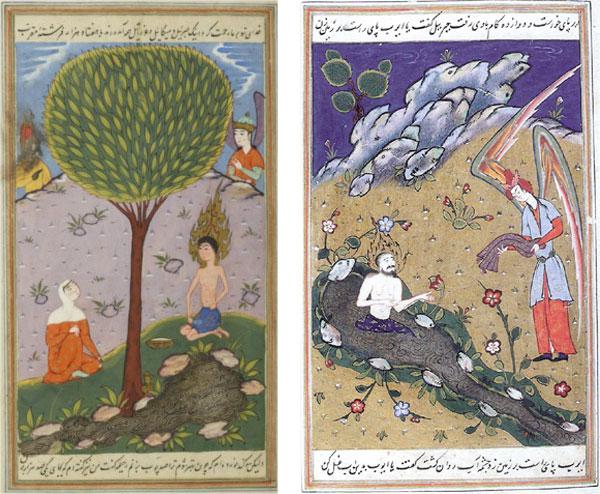
Qisas, Nishaburi, BNF Qisas, Dayduzami, Topkapi
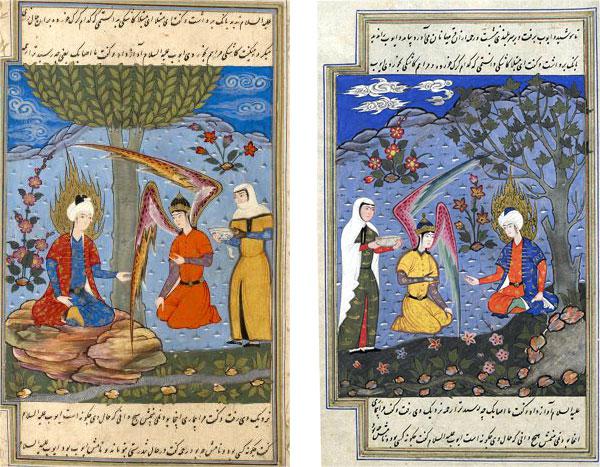
The paintings illuminate various versions of the Islamic midrash called Qisas al Anbiya (Stories of the Prophets), which deals with the pre-Islamic prophets. In all four paintings we find a stream and in three, a tree, usually at the center; these are well-known edenic motifs. Are they connected with the interpretation of the Eden serpent as Satan?; are they evocations of the idyllic situation (Eden, Job’s beginnings) and the disastrous change that is finally reversed? Their common element seems to be Job’s restoration, rather than his suffering. This accords with Job’s appearances in the Quran and the Qisas, which marginalize the suffering, while stressing Job’s great faith in Allah and His mercy.
In two of the paintings Job is half-naked, in other words still in a state of suffering, but never scratching his wounds as in much of Christian art. In the other two paintings, he is dressed and has been restored. In contradistinction to Christian art, the Islamic art on Job portrays a compassionate wife, who is named Rahma (mercy). She appears in two out of four of our pictures, at the point when she is bringing food to her husband who has been restored; according to the Qisas, she does not recognize him at first. Jibril (Gabriel), the archangel, appears in all of the pictures, representing God. In some cases he is simply overseeing the restoration and in others, actively bringing it about with food or clothing. In a single painting (the BNF Qisas), the figure of Iblis (Satan - defaced, on left) appears above Job’s wife and parallel to Jibril, summarizing the conflict between good and evil.
In two of the paintings Job is half-naked, in other words still in a state of suffering, but never scratching his wounds as in much of Christian art. In the other two paintings, he is dressed and has been restored. In contradistinction to Christian art, the Islamic art on Job portrays a compassionate wife, who is named Rahma (mercy). She appears in two out of four of our pictures, at the point when she is bringing food to her husband who has been restored; according to the Qisas, she does not recognize him at first. Jibril (Gabriel), the archangel, appears in all of the pictures, representing God. In some cases he is simply overseeing the restoration and in others, actively bringing it about with food or clothing. In a single painting (the BNF Qisas), the figure of Iblis (Satan - defaced, on left) appears above Job’s wife and parallel to Jibril, summarizing the conflict between good and evil.
On Blake’s Job
The Book of Job was a subject of intense interest to the British romantic poet and artist, William Blake, throughout his life. He is the only pre-20th century artist who deals with the psychological aspect of Job’s rise to consciousness.
In his later years, Blake produced a unified series of twenty-one engravings “illustrating” the book. The first seven engravings accompany the two opening narrative chapters of the book (Job’s beginning, Satan’s challenge, Job’s catastrophes and the smiting of Job). The last six pictures illustrate the final chapter of the book, Job’s restoration. Five pictures concern the argument between Job and his companions and three pictures accompany God’s speech out of the whirlwind. We have chosen seven of the engravings for discussion: Job’s beginning, the smiting of Job, Eliphaz’s vision, Job’s nightly torment, God’s whirlwind, Leviathan and Behemoth, Job’s restoration. We have chosen these pictures for their visual interest and their theological significance.
In his later years, Blake produced a unified series of twenty-one engravings “illustrating” the book. The first seven engravings accompany the two opening narrative chapters of the book (Job’s beginning, Satan’s challenge, Job’s catastrophes and the smiting of Job). The last six pictures illustrate the final chapter of the book, Job’s restoration. Five pictures concern the argument between Job and his companions and three pictures accompany God’s speech out of the whirlwind. We have chosen seven of the engravings for discussion: Job’s beginning, the smiting of Job, Eliphaz’s vision, Job’s nightly torment, God’s whirlwind, Leviathan and Behemoth, Job’s restoration. We have chosen these pictures for their visual interest and their theological significance.
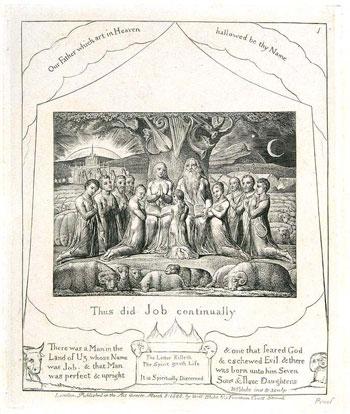
Blake introduces us to Job’s family, in this first of twenty-one images. His children are kneeling in prayer, the good book is open on the parents’ laps, sheep are dozing. Instruments, unused and unsung, are hanging on the tree. A brilliant sun sets over a church on the left and a crescent moon rises on the right over a tent site. The scene is peaceful, but passionless.
The central image is set within an exterior line drawing accompanied by texts. This combination of image and text in the margins will set the pattern for the entire series. The triangular top of a tent fills the upper margin. The text, “Our Father which art in heaven hallowed be thy Name” (Matthew 6:9) appears within a cloud above the tent. The cloud emanates from an altar at the center of the bottom margin.
Below, the opening verse of the book is flanked by a bull and a ram. These are related to the sacrificial altar in the center, on which are quotations from the New Testament:
The word kills, [but] the spirit gives life 2 Corinthians 3:6
It is spiritually discerned 1 Corinthians 2:14
Above the flames of the altar, and serving as the picture's title, is the statement,
The central image is set within an exterior line drawing accompanied by texts. This combination of image and text in the margins will set the pattern for the entire series. The triangular top of a tent fills the upper margin. The text, “Our Father which art in heaven hallowed be thy Name” (Matthew 6:9) appears within a cloud above the tent. The cloud emanates from an altar at the center of the bottom margin.
Below, the opening verse of the book is flanked by a bull and a ram. These are related to the sacrificial altar in the center, on which are quotations from the New Testament:
The word kills, [but] the spirit gives life 2 Corinthians 3:6
It is spiritually discerned 1 Corinthians 2:14
Above the flames of the altar, and serving as the picture's title, is the statement,
(ה) וַיְהִ֡י כִּ֣י הִקִּ֩יפוּ֩ יְמֵ֨י הַמִּשְׁתֶּ֜ה וַיִּשְׁלַ֧ח אִיּ֣וֹב וַֽיְקַדְּשֵׁ֗ם וְהִשְׁכִּ֣ים בַּבֹּ֘קֶר֮ וְהֶעֱלָ֣ה עֹלוֹת֮ מִסְפַּ֣ר כֻּלָּם֒ כִּ֚י אָמַ֣ר אִיּ֔וֹב אוּלַי֙ חָטְא֣וּ בָנַ֔י וּבֵרְכ֥וּ אֱלֹהִ֖ים בִּלְבָבָ֑ם כָּ֛כָה יַעֲשֶׂ֥ה אִיּ֖וֹב כׇּל־הַיָּמִֽים׃ {פ}
(5) When a round of feast days was over, Job would send word to them to sanctify themselves, and, rising early in the morning, he would make burnt offerings, one for each of them; for Job thought, “Perhaps my children have sinned and blasphemed God in their thoughts.” This is what Job always used to do.
referring originally to the sacrifice that Job performed weekly to atone in advance for any possibility of his children’s sins. Is the “Father which art in heaven” (above) aware of the conflict stated below between commandments and faith?
At first blush this picture seems like a mere illustration of the book's opening; but examination of the visual and textual details reveals a striking interpretation. Blake reads Job’s piety as routine, static and unconscious; this is the basis for Job's trials. Blake is setting us up for a shock in the coming scenes.
At first blush this picture seems like a mere illustration of the book's opening; but examination of the visual and textual details reveals a striking interpretation. Blake reads Job’s piety as routine, static and unconscious; this is the basis for Job's trials. Blake is setting us up for a shock in the coming scenes.
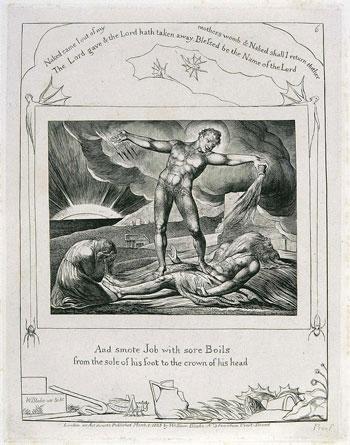
We skip over Satan’s challenge and the test of Job’s piety and over the first round of catastrophes to arrive at Blake’s treatment of Satan smiting Job.
The outer frame sets the mood: creepy spiders, broken pottery, a broken shepherd’s crook, a frog and a grasshopper. These creatures seem allude to the Ten Plagues of Egypt. They are accompanied by the reference to Job’s boils, also one of the Egyptian plagues.
Job’s resigned statement appears at the top:
Naked came I out of my mother’s womb
and naked shall I return thither
The outer frame sets the mood: creepy spiders, broken pottery, a broken shepherd’s crook, a frog and a grasshopper. These creatures seem allude to the Ten Plagues of Egypt. They are accompanied by the reference to Job’s boils, also one of the Egyptian plagues.
Job’s resigned statement appears at the top:
Naked came I out of my mother’s womb
and naked shall I return thither
This is the dismal, ominous outer scene.
The central engraving is a violent storm. Its shape is triangular: Job and his wife are the base; the apex is scary-beautiful, demonic, haloed Satan, standing on his victim. This handsome Satan stands in stark contrast with the traditional Satan we have seen above.
The central engraving is a violent storm. Its shape is triangular: Job and his wife are the base; the apex is scary-beautiful, demonic, haloed Satan, standing on his victim. This handsome Satan stands in stark contrast with the traditional Satan we have seen above.
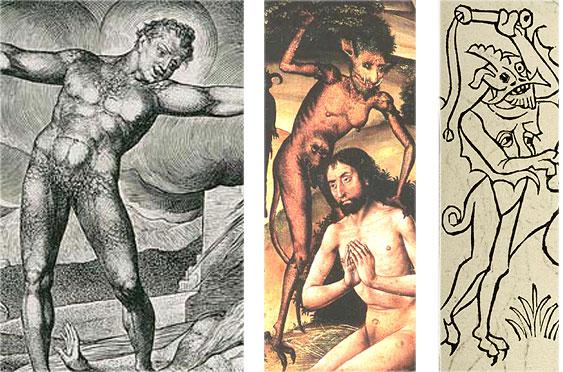
His left hand pours poison on Job, while his right hand hurls arrows, reflecting Job’s words in a later chapter:
(ד) כִּ֤י חִצֵּ֪י שַׁדַּ֡י עִמָּדִ֗י אֲשֶׁ֣ר חֲ֭מָתָם שֹׁתָ֣ה רוּחִ֑י בִּעוּתֵ֖י אֱל֣וֹהַּ יַעַרְכֽוּנִי׃
(4) For the arrows of the Almighty are in me;My spirit absorbs their poison;God’s terrors are arrayed against me.
As can be seen from this quotation, Job attributes his suffering to God; Blake is saying that Satan is an aspect of God, not his nemesis as in medieval iconography. The genitalia of Satan are an additional monster in the medieval painting; in Blake, Satan is asexual.
While not emaciated, Job’s supine position reflects his resignation.
Job’s grieving wife is a sympathetic figure throughout Blake’s work, in contrast to her negative character in many of the treatments seen earlier.
While not emaciated, Job’s supine position reflects his resignation.
Job’s grieving wife is a sympathetic figure throughout Blake’s work, in contrast to her negative character in many of the treatments seen earlier.

The ninth picture of the series deals with Eliphaz’s dream vision in Job 4.
Eliphaz is quoted at the bottom of the outer frame. He raises his arm dramatically, declaiming his vision, while Job and his wife gaze intently. Nearby, the two other companions are frozen in fear.
In fact, Eliphaz appears twice in this engraving: as the confident teller of dreams below and as a terrified dreamer above.
An imperious God stands before Eliphaz. The spikes in Eliphaz’s hair are an extension of God’s radiance:
Eliphaz is quoted at the bottom of the outer frame. He raises his arm dramatically, declaiming his vision, while Job and his wife gaze intently. Nearby, the two other companions are frozen in fear.
In fact, Eliphaz appears twice in this engraving: as the confident teller of dreams below and as a terrified dreamer above.
An imperious God stands before Eliphaz. The spikes in Eliphaz’s hair are an extension of God’s radiance:
(טו) וְ֭רוּחַ עַל־פָּנַ֣י יַחֲלֹ֑ף תְּ֝סַמֵּ֗ר שַׂעֲרַ֥ת בְּשָׂרִֽי׃ (טז) יַעֲמֹ֤ד ׀ וְֽלֹא־אַכִּ֬יר מַרְאֵ֗הוּ תְּ֭מוּנָה לְנֶ֣גֶד עֵינָ֑י דְּמָמָ֖ה וָק֣וֹל אֶשְׁמָֽע׃
(15) A wind passed by me,Making the hair of my flesh bristle. (16) It halted; its appearance was strange to me;A form loomed before my eyes;I heard a murmur, a voice,
Note that the text itself does not identify the speaker in the vision as God.
An oval halo crowns God, who stands within an aura from which sparks like arrows fly toward Eliphaz. A thick cloud frames the entire vision and extends into the margins. Within this marginal cloud is the content of Eliphaz’s vision regarding divine Justice: No human can be righteous in God’s eyes.
Blake reads this passage as the beginning of Job’s new consciousness. Eliphaz is the conduit for the “collective unconscious”, but the companions, and even Eliphaz himself, are not affected by this message from the “Divine”, since they are enslaved to Orthodoxy.
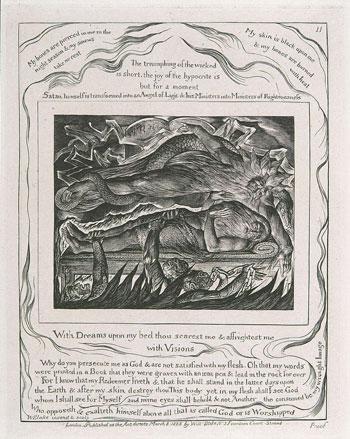
The major text underlying this picture is from Job 7,
(יג) כִּֽי־אָ֭מַרְתִּי תְּנַחֲמֵ֣נִי עַרְשִׂ֑י יִשָּׂ֥א בְ֝שִׂיחִ֗י מִשְׁכָּבִֽי׃ (יד) וְחִתַּתַּ֥נִי בַחֲלֹמ֑וֹת וּֽמֵחֶזְיֹנ֥וֹת תְּבַעֲתַֽנִּי׃
(13) When I think, “My bed will comfort me,My couch will share my sorrow,” (14) You frighten me with dreams,And terrify me with visions,
In this engraving, Job is caught between creatures beneath his bed that are pulling him down to hell and God, hovering above, malevolently. God’s right arm points to the Tablets of the Law and his left arm to hell: The all-powerful God is coercing Job into following the letter of the Law or else… For Blake, this is a proof that the Law is invalid.
Blake’s engraving of this scene is similar in many ways to his painting entitled “And Elohim created Adam…”. Is Job the universal Adam?
Blake’s engraving of this scene is similar in many ways to his painting entitled “And Elohim created Adam…”. Is Job the universal Adam?
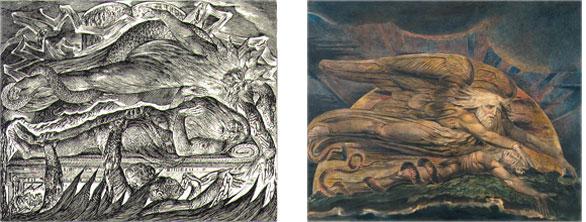
William Blake,Job's nightmare (detail) Elohim creating Adam
In the Creation painting, Adam is wrapped in the Serpent; in the Job engraving God is wrapped in the Serpent, whose head seems to grow out of God’s head. God is more benign in the Creation painting than in the Job engraving, he is blessing Adam. Nonetheless, in Blake’s theology, this Creator God is a false God, because he deals with the material world rather than pure spirit. The monstrous God in the Job engraving is anticipated in the Creation painting. The images of Adam and God and Job and God are merging. It’s as though the suffering Adam will become the suffering Job, the Job who protests against his very existence already in chapter 3.
The picture is accompanied by copious text, from various parts of Job, as well as from the New Testament. Particularly significant is the long quotation from Job 19, which Blake translated differently than the King James Version, his usual source. The quotation also diverges from the Hebrew original. Blake’s reading is that the Redeemer will be met once Man (Job) is divested of his mortal body and is able to experience the true, spiritual world. Job is still caught between Heaven and Hell, but Earth itself, because of its very materiality, is his nightmare.
The picture is accompanied by copious text, from various parts of Job, as well as from the New Testament. Particularly significant is the long quotation from Job 19, which Blake translated differently than the King James Version, his usual source. The quotation also diverges from the Hebrew original. Blake’s reading is that the Redeemer will be met once Man (Job) is divested of his mortal body and is able to experience the true, spiritual world. Job is still caught between Heaven and Hell, but Earth itself, because of its very materiality, is his nightmare.
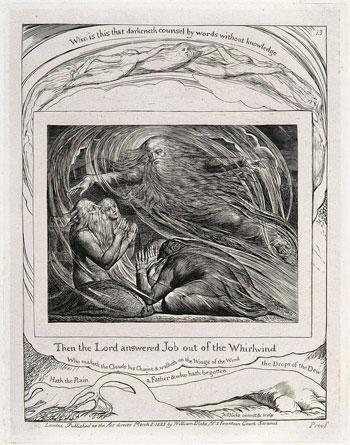
The next picture we deal with in Blake’s opus is the Lord’s stunning appearance out of the whirlwind (Job 38). The demonic God and the suffering Job are gone. This God speaks out of a womblike whirlwind, reminiscent of Michelangelo's God of Creation in the Sistine Chapel. He no longer torments Job; instead his right hand reaches out in blessing. Blake reads against the biblical text, which describes an imperious God holding forth haughtily out of the whirlwind and confronting Job with his insignificance.
The hands of Job and his wife respond in prayer. It is the three companions who are doubled over in terror. Their agitated hands are in total contrast to the calm figures of Job and his wife. In God’s speech itself, neither the companions nor Job’s wife are mentioned.
Typically, biblical quotations accompany the central engraving. Below the engraving, as a caption, appears the first verse of chapter 38:
Typically, biblical quotations accompany the central engraving. Below the engraving, as a caption, appears the first verse of chapter 38:
(א) וַיַּֽעַן־יהוה אֶת־אִ֭יּוֹב (מנהסערה) [מִ֥ן ׀ הַסְּעָרָ֗ה] וַיֹּאמַֽר׃
(1) Then the LORD replied to Job out of the tempest and said:
Strangely the next verse of the text (God’s disdainful challenge to Job) appears at the top of the page’s margin, almost out of sight. Below this quotation five figures, arms linked, float above clouds: an image from Psalms 104:
Who maketh the Clouds his chariot
and walketh on the Wings of the Wind.
Who maketh the Clouds his chariot
and walketh on the Wings of the Wind.
But the quotation is minimized at the lower margin; why doesn’t the caption accompany the illustration? And why make reference to this particular Psalm?
Further down the page is another quotation from Job 38, mentioning God as the bringer of rain and dew; at the bottom edge is a tree, whose branches have been bent down by the storm.
These enigmatic elements can be explained as Blake’s reinterpretation of the whirlwind as a symbol of God’s benevolence, rather than as a manifestation of God’s power.
Further down the page is another quotation from Job 38, mentioning God as the bringer of rain and dew; at the bottom edge is a tree, whose branches have been bent down by the storm.
These enigmatic elements can be explained as Blake’s reinterpretation of the whirlwind as a symbol of God’s benevolence, rather than as a manifestation of God’s power.
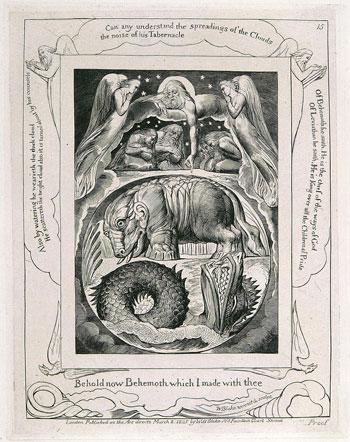
As always, the passage below the picture (Job 40:15) indicates its major focus.
Behold now Behemoth which I made with thee
Behold now Behemoth which I made with thee
The phrasing of this verse is noteworthy for two reasons. First, the word “behold” emphasizes the need to look at and contemplate these beasts (the term “behemoth” indicating more than one). Second, the words “which I made with thee” invite a psychological interpretation, because it appears that the beast is part of the person, Job. The other quotations, in the margins, emphasize man’s inability to understand the external world.
In the central engraving itself, the nimbed God is flanked by two brooding angels. The dispirited Lord points downward to the lower world. Job, his wife and the companions follow Gods hand, peering over the edge as if into an abyss.
Two-thirds of this plate is occupied by the monsters, Behemoth and Leviathan. Behemoth looks like an armored hippopotamus, while Leviathan is a classic sea dragon. They are enclosed within a womb-like sphere, reminiscent of the early verses of God’s speech out of the whirlwind:
Who closed the sea behind doors
When it gushed forth out of the womb,
When I clothed it in clouds,
Swaddled it in dense clouds,
When I made breakers My limit for it,
And set up its bar and doors,
And said, “You may come so far and no farther;
Here your surging waves will stop”? 38: 8 – 11
In the central engraving itself, the nimbed God is flanked by two brooding angels. The dispirited Lord points downward to the lower world. Job, his wife and the companions follow Gods hand, peering over the edge as if into an abyss.
Two-thirds of this plate is occupied by the monsters, Behemoth and Leviathan. Behemoth looks like an armored hippopotamus, while Leviathan is a classic sea dragon. They are enclosed within a womb-like sphere, reminiscent of the early verses of God’s speech out of the whirlwind:
Who closed the sea behind doors
When it gushed forth out of the womb,
When I clothed it in clouds,
Swaddled it in dense clouds,
When I made breakers My limit for it,
And set up its bar and doors,
And said, “You may come so far and no farther;
Here your surging waves will stop”? 38: 8 – 11
It’s as if God is saying to Job, “You’ve been focused and either satisfied or angry regarding external reality. Now, look inside at what is running you.” Job needs to understand that these monstrous beings are his primal instincts and are not to be denied, but embraced, because they are the basis of human creativity.
Blake presents this climactic part of God’s speech to Job saying that even if we cannot understand the mysteries of the outer or inner world, still we must engage them.
Blake presents this climactic part of God’s speech to Job saying that even if we cannot understand the mysteries of the outer or inner world, still we must engage them.
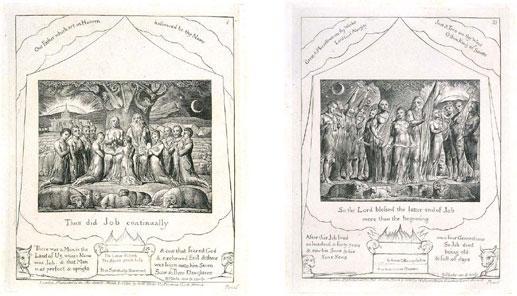
The final picture in Blake’s series is entitled “So the Lord blessed the end of Job more than the beginning (Job 42:12). It is the companion piece to the engraving of Job's beginning. There are three points to address in comparing the two: the outer frame, the verses and the interior picture.
Both scenes take place within a tent at the bottom of which is an altar. The verse within the altar in the restoration scene rejects the importance of sacrifice and sin, parallel to the opening picture, where the verse on the altar is a rejection of the Law.
Job’s restored family is a standing chorus here, joyously singing and playing musical instruments, as opposed to the first in the series where they are seated solemnly, focused on the written word, the instruments hanging silently on the tree. The moon sets as the sun rises, reversing the focus of the first engraving, where the setting of the sun augurs darkness.
The text above the tent now exults in praise of God’s works on earth, while the first engraving quoted stylized piety, invoking the heavenly God.
Both scenes take place within a tent at the bottom of which is an altar. The verse within the altar in the restoration scene rejects the importance of sacrifice and sin, parallel to the opening picture, where the verse on the altar is a rejection of the Law.
Job’s restored family is a standing chorus here, joyously singing and playing musical instruments, as opposed to the first in the series where they are seated solemnly, focused on the written word, the instruments hanging silently on the tree. The moon sets as the sun rises, reversing the focus of the first engraving, where the setting of the sun augurs darkness.
The text above the tent now exults in praise of God’s works on earth, while the first engraving quoted stylized piety, invoking the heavenly God.

Job in Modern Art
Jews dominate the art of Job in the 20th century. While the Holocaust is a central catalyst for their work, the art of Job already appears before the Holocaust and also relates to non-Holocaust issues. The common denominator is that Job is an iconic image of the incomprehensibility of the world. Only in the 20th century did the world of art open fully to Jews and only in the 20th century could Job be reinterpreted in a secular manner. His tragedy is all of human tragedy, his protest is both heroic and unfathomable.
Pre-holocaust Job
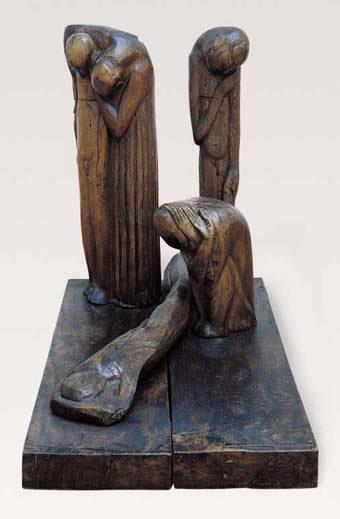
Our first example of a modern Job fits the hallmarks of our era. Ossip Zadkine came from an assimilated/converted Jewish family in Vitebsk, who provided him little or no traditional Jewish background. Arriving in Paris in 1910, he was influenced by cubism on the one hand and Roman and African sculpture on the other to “search for life in the simplification” of forms. His Job of 1914, carved from elm wood, expresses his personal difficulties, rather than being a theological, political or philosophical statement. The four figures, presumably Job (lying face down), his three companions and his wife (bending over him), appear to have no relationship with one another – modern alienation.
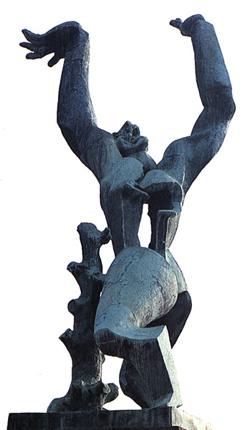
Zadkine's The Destroyed City (1951) is a man without a heart and is dedicated to the city of Rotterdam, destroyed by the Nazi Luftwaffe. It may not be named Job, but it is a Jobian work, a much more powerful sculpture, of related iconography, than the elmwood sculpture of 1914, which feels self-absorbed in comparison. Zadkine was wounded during WWI and the later sculpture is by the artist 30+ years older with a lot more life experience to express. As we shall see the raised arms are similar to Abraham Rattner’s work of about this time. Both men were in the US during WWII.
The Holocaust as reflected in Job
The Holocaust was certainly the overwhelming Jewish experience of the 20th century; in trying to give meaning to this horror, Jews reached back to the Bible and found the book of Job waiting. Both in literature and in art, the figure of Job became a central icon dialoguing with the victims of the Holocaust.
After serving in World War I, Abraham Rattner became part of the American expatriate community of Paris, until returning to the United States in 1940. He joined other Jewish expatriates and refugees, including Ossip Zadkine, in the vibrant art scene of New York City. The Holocaust marks the beginning of Rattner’s treatment of Jewish and biblical topics.
After serving in World War I, Abraham Rattner became part of the American expatriate community of Paris, until returning to the United States in 1940. He joined other Jewish expatriates and refugees, including Ossip Zadkine, in the vibrant art scene of New York City. The Holocaust marks the beginning of Rattner’s treatment of Jewish and biblical topics.
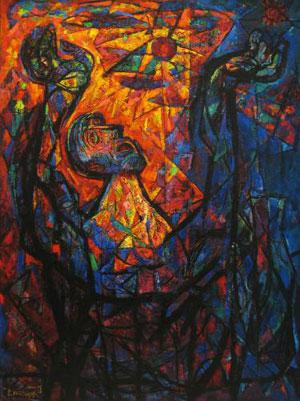
In his painting of 1949, Job’s head and body move toward abstraction; his face is raised, questioning the Almighty. His sores are patches of color in the abstract triangle of his body. He’s surrounded by fire. Most unique are his arms, disproportionately huge, raised to heaven. If arms could speak, the volume would be deafening.
Ziva Amishai- Maisels writes on Rattner development:
“… in later versions his gesture is more hesitant, as he asks God what he has done to be so punished… Job’s sores also take on another meaning in the versions of 1958-59, where his body breaks down into an abstract composition of flame-colored facets and dripping blood, and is set against a blazing background.” Depiction and Interpretation, p. 165
Ziva Amishai- Maisels writes on Rattner development:
“… in later versions his gesture is more hesitant, as he asks God what he has done to be so punished… Job’s sores also take on another meaning in the versions of 1958-59, where his body breaks down into an abstract composition of flame-colored facets and dripping blood, and is set against a blazing background.” Depiction and Interpretation, p. 165
Jacob Steinhardt
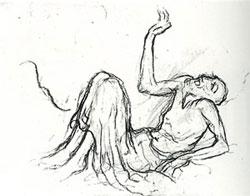
Steinhardt, 1945
The German Expressionist Jacob Steinhardt treated Job repeatedly over 50 years. In his earlier and later works, Steinhardt portrayed Job as depressed and withdrawn. During and immediately after World War II, his treatments evoke the Holocaust and his feelings of protest. Only at this time do Steinhardt’s Jobs look heavenward, mouth open, questioning God and expressing incomprehension.
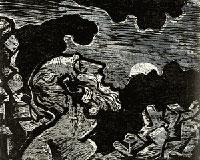
Nathan Rapoport
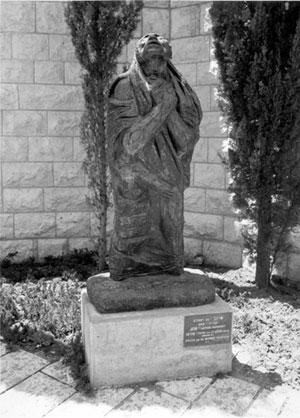
Rapoport, 1967
Much of Nathan Rapoport’s work concerns the Holocaust, through which he lived. Regarding his cast bronze sculpture of Job, now found in the gardens of Yad Vashem, Rapoport writes:
“I think…that the rebirth of Israel and the Jewish people are an echo of the book of Job. Our people kept faith. We did not change our beliefs, our ethics, and we came out stronger from our ordeals.”
However, some commentators have asked whether Rapoport’s figure of Job is the man of faith, sure of his belief or the man of protest, lifting his face heavenward asking God, “why”.
“I think…that the rebirth of Israel and the Jewish people are an echo of the book of Job. Our people kept faith. We did not change our beliefs, our ethics, and we came out stronger from our ordeals.”
However, some commentators have asked whether Rapoport’s figure of Job is the man of faith, sure of his belief or the man of protest, lifting his face heavenward asking God, “why”.
Leonard Everett Fisher
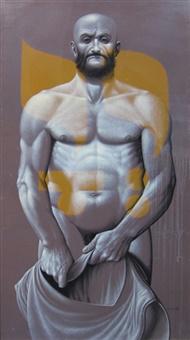
In unsettling contrast to the image of Job the emaciated martyr, prevalent both in medieval Christian art and in some modern Jewish art, Leonard Everett Fischer portrays Job as a robust, aggressive man, ready for combat. This view of Job reflects both Fischer’s biography (which included active service in World War II) and his interest in heroic figures in general. But it is also a reaction to the perceived helplessness of Jews in the Holocaust and the desire to redefine Jewish identity. The title of the painting, based on Job 1:21, refers to the stoic Job, unbroken by his own tragedy.
Marc Chagall
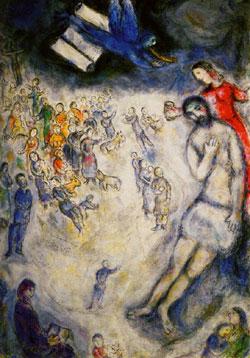
Chagall, 1975
Marc Chagall treated the subject of Job several times. In this painting from 1975, Job is only partially clothed, as in many traditional paintings. But he is not emaciated and there is no sign of him acting as representative of the Holocaust martyrs. He stands in an unnatural posture, together with his wife, who holds out a cup or donation box (pushke). A crowd (perhaps his acquaintances) stands opposite, coming to visit him:
(יא) וַיָּבֹ֣אוּ אֵ֠לָ֠יו כׇּל־אֶחָ֨יו וְכׇל־אַחְיֹתָ֜יו וְכׇל־יֹדְעָ֣יו לְפָנִ֗ים וַיֹּאכְל֨וּ עִמּ֣וֹ לֶחֶם֮ בְּבֵיתוֹ֒ וַיָּנֻ֤דוּ לוֹ֙ וַיְנַחֲמ֣וּ אֹת֔וֹ עַ֚ל כׇּל־הָ֣רָעָ֔ה אֲשֶׁר־הֵבִ֥יא יהוה עָלָ֑יו וַיִּתְּנוּ־ל֗וֹ אִ֚ישׁ קְשִׂיטָ֣ה אֶחָ֔ת וְאִ֕ישׁ נֶ֥זֶם זָהָ֖ב אֶחָֽד׃
(11) All his brothers and sisters and all his former friends came to him and had a meal with him in his house. They consoled and comforted him for all the misfortune that the LORD had brought upon him. Each gave him one kesitah and each one gold ring.
A Chagallian potpourri populates the scene: an angel with open scroll flying above, goats, a Christ on the cross, a Torah scholar, etc. We suggest that the central structure of the painting, a circular movement composed of Job and his wife and the people of Israel, is the key the Chagall’s statement regarding Job: renewal and hope.
Adi Nes
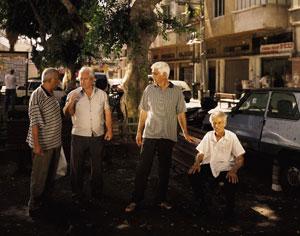
Job and his companions, 2006
Adi Nes’ Job is spectacularly different from what we have seen up to now. The scene has been transported to a seedy neighborhood of south Tel Aviv. Removed from the theological conversation of the book of Job, they are our neighbors, perhaps talking about their friend, who is down on his luck. They seem to be more involved in their discussion than in Job himself. He sits alone, unfocused, bedraggled and lost. This is a true example of modern midrash, which creates a contemporary dialogue with an ancient text.
We have seen through this survey of art on the book of Job that the difficult and challenging form and content of the book has engendered radically different interpretations, the artist like the writer often finding in Job a mirror.
We have seen through this survey of art on the book of Job that the difficult and challenging form and content of the book has engendered radically different interpretations, the artist like the writer often finding in Job a mirror.
For additional images on this subject see TALI Visual Midrash



